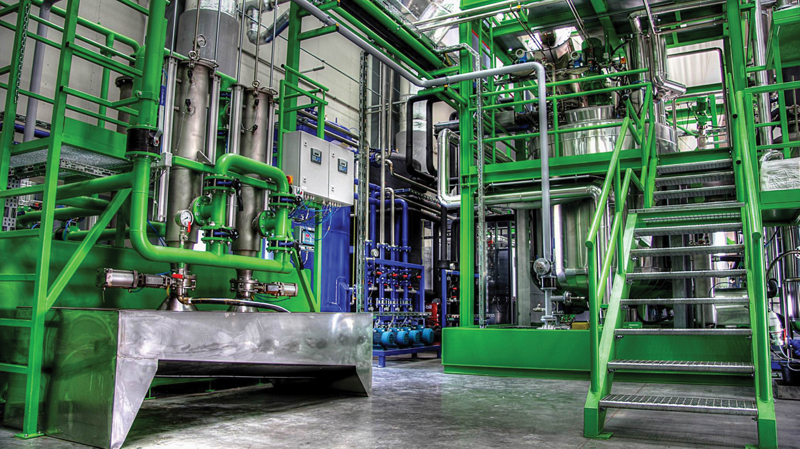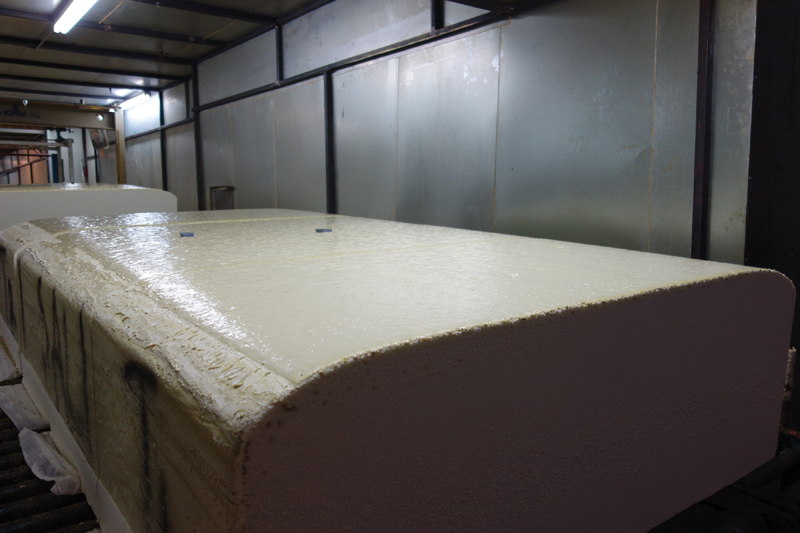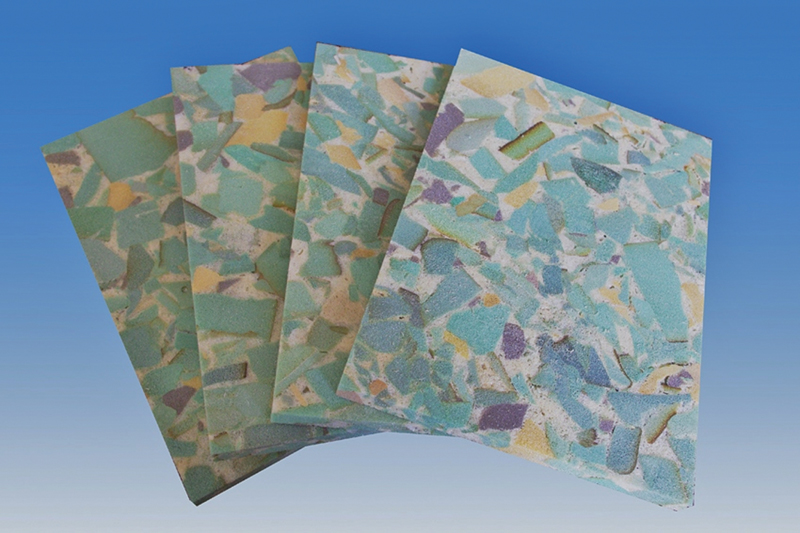[1].jpg)
A pilot plant in Germany is using CO2 recovered from a nearby power plant to make the polyol component of polyurethane soft foam (photo courtesy of Bayer MaterialScience).
[1].jpg)
A pilot plant in Germany is using CO2 recovered from a nearby power plant to make the polyol component of polyurethane soft foam (photo courtesy of Bayer MaterialScience).

Recovered polyol reportedly can substitute for 20% of the original polyol for PUR without any losses in quality (photo courtesy of H&S Anlagentechnik).

Recovered polyol reportedly can substitute for 20% of the original polyol for PUR without any losses in quality (photo courtesy of H&S Anlagentechnik).

A foam mattress manufacturer uses a system from H&S Anlagentechnik for the industrial recycling of flexible foam scrap.

Natural Foams Technology specializes in developing biorenewable foams.
Get Up-to-Date on Materials and Technology at FOAMS® 2014
This year’s SPE FOAMS tutorial and conference will take place at the Renaissance Woodbridge Hotel in Iselin, New Jersey, USA, on Sept. 8-11. The technical program will include topics such as polymer foam sustainability, foaming technologies, new materials and properties, and applications.Max Wingert, chair of the conference, says thatnew activities for this year include a panel discussion on the future direction of polymer foams. Visit www.4spe.org/foams2014 or e-mail mw4spe@yahoo.com for more information.
Recycling Rigid Foams
At last year’s SPE FOAMS® conference, Dr. Wenguang Ma, chief scientist and director of the technical center of Changzhou Tiansheng New Materials Inc. in China, presented a method for recycling polyurethane and PVC rigid foams. The company, a large manufacturer of PVC rigid foam for sandwich composite applications, was looking for ways to be more sustainable in handling foam scraps.
Because thermoset foam scraps are not easily recycled into new products using a melting process, and the energy required to ground the material into powder is prohibitive, Dr. Ma and his research group developed an easier process. They chopped rigid foam wastes into small cubes and then mixed the small blocks with foamable adhesives such as polyurethane. They placed this mixture into a mold and pressed it into a new foam block, which could be sliced into sheets and used as the foam core material for sandwich composites.
Through experiments, Ma and his colleagues found that cubes chopped at sizes between 20 and 100 mm worked best, as did a polyurethane adhesive content of 35 wt%. Their tests of a sandwich panel made from the foam showed that the recycled core had properties similar to those of the virgin foam, except for lower toughness.
Ma reports that since presenting this paper, they have used the recycled core to make a sandwich composite product for construction applications. He adds that another group is working on reusing the wastes of thermoset foam in other ways, such as using the powder waste as fillers for different applications.

These sheets are made from thermoset rigid foam scraps chopped into cubes, mixed with foamable adhesive, and pressed into a new foam block.
The U.S. demand for plastic foams is predicted to reach 8.6 billion pounds in 2017, according to a market research report by Freedonia Group Inc., and the report identifies polyurethane as the leading resin in the plastic foams market. Along with a growing market for polyurethane foams comes increasing consumer pressure to make these foams more environmentally friendly, which can also bring economic benefits.
Thus efforts are underway to produce foams that contain less crude oil and that integrate flame retardants that don’t give off fumes. Companies are also developing new approaches to recycle these foams.
Foam from a Greenhouse Gas
Bayer MaterialScience is focusing on the commercialization stage for a process that uses the greenhouse gas carbon dioxide (CO2) from power plant emissions to replace some of the crude oil typically used to make polyurethane foam. Called the “Dream Production” research initiative, Bayer and its research partners have demonstrated that incorporating CO2 into polyurethane can be a reality.
At a pilot plant in Germany, Bayer has been manufacturing samples of the polyurethane component polyol using CO2 that’s removed from the emissions of a nearby power plant. The key to producing polyol from CO2 was a zinc-based catalyst discovered by a Bayer research team several years ago. Test foams made from this polyol match the quality of those produced the conventional way using only petroleum.
“We are very pleased with the new process,” says Julia Rubino, director of industrial marketing for Polyurethanes North America at Bayer MaterialScience.“All our expectations have been met in full—the technology works, and the new CO2-based materials are of high quality. We have successfully completed the research phase and are looking forward to commercializing the new process.”
The company is now focused on commercializing the use of CO2 to produce the polyol component of polyurethane soft foam. It’s in the evaluation stage of building a production plant in Dormagen, Germany, that would have an annual capacity of several thousand tons and serve the market beginning in 2016. The company is also looking into licensing the technology. “We believe that in 2016 we will be ready to launch [the] first CO2-based polyols that can be used to produce polyurethane foam for mattresses,” Rubino says.
She adds that the company is examining the production of products other than polyurethane foam with the help of CO2 and is conducting research projects aimed to further increase the amount of alternative feedstock such as CO2 in primary products for plastics.
Chemical Recycling
“All modern approaches to the sustainable production of polyurethane foam, like implementing bio-based raw materials, CO2 polyols, and mechanical recycling, are important, and they should be developed further,” says Lyudmila Skokova of H&S Anlagentechnik. The company makes equipment for the chemical recycling of polyurethane waste and for generating polyester polyols based on PET and polyamide.
“Chemical recycling is the only method that enables recovery of a basic raw material out of polyurethane waste. From our point of view, chemical recycling should also become one of the main trends in the sustainability concept of the polyurethane production.”
In 2013, H&S Anlagentechnik installed the first system for flexible foam recycling at Dendro Poland, which makes foam mattresses for IKEA. After cutting the polyurethane foam blocks, H&S equipment converts the scrap into recovered polyol. The process uses optimized acidolysis and involves feeding polyurethane waste crushed into small pieces into the reactor vessel via a specially designed screw conveyor.
The system automates dosing of all raw materials, agitating, and thermal treatment, as well as filtering in a process-controlled way. The reactors are closed and fully insulated vessels with pipe coils filled with thermal oil for controlling the temperature. H&S also supplies auxiliary equipment such as activating and cooling tanks, a temperature control system, silo and feeding system for shredded polyurethane residues, and storage tanks for basic and recovered polyols.
For conventional foam, the recovered polyol can substitute for 20% of the original polyol without quality loss, and in some cases there’s improvement in foam parameters such as resilience. Dendro runs the production of recycled polyol daily, which not only makes its manufacturing processes less wasteful but also saves money, since manufacturing the recovered polyols costs 30% less than the market price of virgin basic polyol.
Skokova says that the technology is currently used for conventional foam and has been developed and approved for high-resilience foam, but the company would like to also implement it for other polyurethane foams, such as viscoelastic foams. “We are also planning to develop a technology or adapt the existing one for post-consumer mattress recycling,” she says.
Safer Flame Retardants
Natural Foams Technology of Derbyshire, UK (previously known as Green Urethanes), specializes in developing biorenewable foams for the furnishing, bedding, and automotive industries. The company recently developed a bio-renewable foam with a flame suppressant safely “reacted-in,” and also offers a version of the foam without any flame suppressant.
“There’s understandable public distrust of flame retardants, but also an undeniable truth that foam, by nature, adds to any fire situation,” says the company’s director Jeff Rowlands. As one result, California’s flammability standards Technical Bulletin 117 (TB 117) was adopted in 1975, and many manufacturers sold TB 117-compliant furniture containing flame retardants across the USA and Canada. But in response to concerns about health and environmental effects from certain flame retardants, a new, less-demanding version of TB 117 which doesn’t require the use of flame retardants went into effect in January.
Rowlands says that the company’s new flame-retardant foam could have easily passed the original and tougher TB 117 open-flame test, without harmful emissions. Working with specialty chemicals supplier Clariant, Natural Foams created the foam using Clariant’s Exolit OP 560 as the flame retardant. The U.S. Environmental Protection Agency’s New Chemicals Program P2 recognized this additive for its unique chemistry that allows maximum flame-retardant efficiency without releasing potentially toxic gases into the atmosphere when combusted.
A highly reactive non-halogenated process permanently bonds the flame retardant into the matrix of the foam. The efficiency of the reaction and the characteristics of biomaterials reduce the additive needed by 80%, while still achieving the level of fire protection typically seen in standard foam. Heat, stress, and gas-phase analyses showed no extractable traces of the suppressant in the foam, as well as impressively low overall smoke and emissions numbers.
Building on this knowledge, Natural Foams Technology expects to introduce a 50% by weight biorenewable foam into the USA this summer. “This would mark a technical milestone of replacing 82% of the petrochemical material with renewable natural polyols,” says Rowlands. Natural Foams already developed a 35% bio-based foam (with a 55% petrochemical replacement) that’s produced by North Carolina-based NCFI Polyurethanes as their BioLuxMax range.
